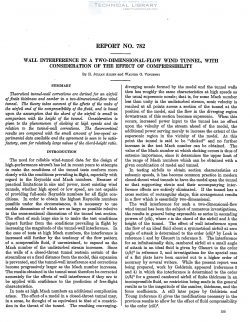naca-report-782

- Version
- 154 Downloads
- 2.81 MB File Size
- 1 File Count
- August 30, 2016 Create Date
- August 30, 2016 Last Updated
National Advisory Committee for Aeronautics, Report - Wall Interference in a Two Dimensional Flow Wind Tunnel, with Consideration of the Effect of Compressibility

Theoretical tunnel-wall corrections are derived for an airfoil
offinite thickness and camber in a two-dimensional—flmo wind
tunnel. The theory takes account of the efects of the wake of
the airfoil and of the compressibility of the fluid, and is based
upon the assumption that the chord of the auj‘oil is small in
comparison with the height of the tunnel. Consideration is
given to the phenomenon of choking at high speeds and its
relation to the tunnel-wall corrections. The theoreoretical
results are compared with the small amount of low—speed ew-
perimental data available and the agreement is seen to be satis-
factory, even for relatively large values of the chord-height ratio.
The need for reliable wind-tunnel data for the design of
high-performance aircraft has led in recent years to attempts
to make the conditions of the tunnel tests conform more
closely with the conditions prevailing in flight, especially with
regard to the Reynolds and Mach numbers. Because of
practical limitations in size and power, most existing wind
tunnels, whether high speed or low speed, are not capable
of providing full-scale Reynolds numbers for all flight con—
ditions. In order to obtain the highest Reynolds numbers
possible under the circumstances, it is necessary to use
models dimensions of which are as large as possible relative
to the cross-sectional dimensions of the tunnel test section.
The effect of such large size is to make the test conditions
depart further from the conditions prevailing in flight by
increasing the magnitude of the tunnel-wall interference. In
the case of tests at high Mach numbers, the interference is
increased still further by the tendency of the flow pattern
of a compressible fluid, if unrestrained, to expand as the
Mach number of the undisturbed stream increases. Since
the walls of a closed-throat timnel restrain certain of the
streamlines at a fixed distance from the model, this expansion
is prevented, and the tunnel-wall interference and corrections
become progressively larger as the Mach number increases.
The results obtained in the tunnel must therefore be corrected
accurately for the effects of wall interference if they are to
be applied with confidence to the prediction of free-flight
characteristics.
| File | Action |
|---|---|
| naca-report-782 Wall Interference in a Two Dimensional Flow Wind Tunnel, with Consideration of the Effect of Compressibility.pdf | Download |

Comment On This Post